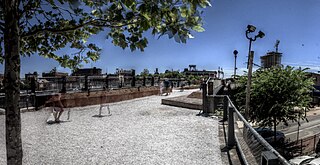
The Reading Company was a Philadelphia-headquartered railroad that provided passenger and freight transport in eastern Pennsylvania and neighboring states from 1924 until its acquisition by Conrail in 1976.

The SEPTA Regional Rail system is a commuter rail network owned by SEPTA and serving the Philadelphia metropolitan area. The system has 13 branches and more than 150 active stations in Philadelphia, Pennsylvania, its suburbs and satellite towns and cities. It is the sixth-busiest commuter railroad in the United States. In 2016, the Regional Rail system had an average of 132,000 daily riders and 118,800 daily riders as of 2019.

The Reading Viaduct, also called The Rail Park, is a disused elevated rail line in the Callowhill district of Philadelphia, Pennsylvania, United States that has been partly transformed into a rail trail.

Norristown Transportation Center is a two-level multimodal public transportation regional hub located in Norristown, Pennsylvania and operated by SEPTA. It opened in 1989, replacing the older Norristown High Speed Line terminus one block away at Main and Swede Streets, and integrated the former Reading Company's DeKalb Street Norristown railroad station into its structure. A plaque embedded in the sidewalk between the bus lane and Lafayette Street commemorates the location of one of the columns of the dismantled segment of the Philadelphia and Western Railroad (P&W) trestle.

The SEPTA Main Line is the section of the SEPTA Regional Rail system from the Zoo Interlocking in West Philadelphia to Lansdale Station in Lansdale, Pennsylvania. The line is 26.25 miles (42.25 km) long, and serves all 13 SEPTA Regional Rail lines.

Wayne Junction station is a SEPTA Regional Rail junction station located at 4481 Wayne Avenue, extending along Windrim Avenue to Germantown Avenue. The station is located in the Nicetown neighborhood of Philadelphia. Wayne Junction serves as a multi-modal transfer point between six of SEPTA's regional rail lines as well as three major transit routes – the Route 75 Trackless Trolley and the Route 23 and 53 bus lines. The station served more than 321,000 riders annually in 2018.

Manayunk station is a station located along the SEPTA Manayunk/Norristown rail line. It is located at Cresson and Carson Streets in the Manayunk neighborhood of northwest Philadelphia, Pennsylvania. In FY 2013, Manayunk station had a weekday average of 654 boardings and 563 alightings.
North Pennsylvania Railroad was a railroad company which served Philadelphia, Montgomery County, Bucks County and Northampton County in Pennsylvania. It was formed in 1852, and began operation in 1855. The Philadelphia and Reading Railway, predecessor to the Reading Company, leased the North Pennsylvania in 1879. Its tracks were transferred to Conrail and the Southeastern Pennsylvania Transportation Authority (SEPTA) in 1976.

The Schuylkill Branch was a rail line owned and operated by the former Pennsylvania Railroad (PRR) in Pennsylvania. The line ran from the Philadelphia to Harrisburg Main Line at 52nd Street in Philadelphia north via Norristown, Reading, and Pottsville to Delano Junction, about 2.5 mi (4.0 km) northeast of Delano. From Delano Junction, the PRR had trackage rights over the Lehigh Valley Railroad's Hazleton Branch and Tomhicken Branch to Tomhicken, where the PRR's Catawissa Branch began.

SEPTA's Trolley Route 60, the Allegheny Avenue Line is a former streetcar line and current bus route, operated by the Southeastern Pennsylvania Transportation Authority (SEPTA) in Northwest and Northeast Philadelphia, Pennsylvania, United States. It connects to the East Falls to the Port Richmond, and runs primarily along Allegheny Avenue.

The Manayunk/Norristown Line is a commuter rail service in Southeastern Pennsylvania between Center City Philadelphia and Norristown, and one of the 13 lines in SEPTA's Regional Rail network. It has the second highest operating ratio (19.9%) on the SEPTA Regional Rail network.

The Chestnut Hill East Line is a route of the SEPTA Regional Rail system. The route serves the northwestern section of Philadelphia with service to Germantown, Mount Airy, and Chestnut Hill. It is one of two lines that serve Chestnut Hill, the other one being the Chestnut Hill West Line. The line is fully grade-separated.

The Chestnut Hill West Line is a commuter rail line in the SEPTA Regional Rail network. It connects Northwest Philadelphia, including the eponymous neighborhood of Chestnut Hill, West Mount Airy, and Germantown, to Center City.

Shawmont is a former train station in Philadelphia, Pennsylvania. It is located on Nixon Street in the Roxborough section of Lower Northwest Philadelphia. Built by the Philadelphia, Germantown and Norristown Railroad, it later became part of the Reading Railroad and ultimately SEPTA Regional Rail's R6 Norristown Line. SEPTA made the station a whistle stop and closed its waiting room in 1991. SEPTA later closed the station in 1996. In 2018, $1 million was set aside for repairs and rehabilitation.

The Ninth Street Branch was an elevated railway line in Philadelphia, Pennsylvania. It was operated by the Reading Company; ownership was split between the Reading and its subsidiary the Philadelphia, Germantown and Norristown Railroad. It was a four-tracked main line beginning at the Reading Terminal, the Reading's terminus in Philadelphia, and extending north into the city to a junction with the Bethlehem Branch. After the final bankruptcy of the Reading the line passed to Conrail and later SEPTA. The portion south of the Temple University station was abandoned in 1984 with the opening of the Center City Commuter Connection and is now known as the Reading Viaduct; the portion north is now part of the SEPTA Main Line.
The Stony Creek Branch is a railway line in Montgomery County, Pennsylvania. It runs 9.9 miles (15.9 km) from Lansdale, Pennsylvania, to Norristown, Pennsylvania, connecting the Bethlehem and Doylestown Branches with the Norristown Branch. Although SEPTA owns the line, it is freight-only. CSX Transportation, Norfolk Southern Railway, and the Pennsylvania Northeastern Railroad have trackage rights on the branch.

The Norristown Branch is a railway line in Pennsylvania. It runs 14.6 miles (23.5 km) from a junction with the SEPTA Main Line in North Philadelphia to Norristown, Pennsylvania. It was originally built by the Philadelphia, Germantown and Norristown Railroad (PG&N) in 1834, and was a part of the Reading Company system from 1870 until 1976. Today it is owned by SEPTA and hosts the Manayunk/Norristown Line commuter rail service.
The Main Line of the Reading Company was a railway line in the U.S. state of Pennsylvania. The 88-mile-long (142 km) main line ran from Philadelphia to Pottsville, Pennsylvania, following the Schuylkill River.
The Chestnut Hill East Branch is a railway line in Pennsylvania. It runs 5.5 miles (8.9 km) from a junction with the SEPTA Main Line in Nicetown–Tioga, a neighborhood in Philadelphia, to Chestnut Hill, Philadelphia. The oldest part of it was built in 1832 by the Philadelphia, Germantown and Norristown Railroad. It was part of the Reading Company system from 1870 until 1976. Today it is owned by SEPTA and hosts the Chestnut Hill East Line commuter rail service. The line runs roughly parallel to the Chestnut Hill West Branch, formerly of the Pennsylvania Railroad.
The Fox Chase Branch, formerly the Newtown Branch, is a railway line in the state of Pennsylvania. It runs 4.9 miles (7.9 km) from a junction with the SEPTA Main Line near Wayne Junction to Fox Chase. At its fullest extent, it continued another fifteen miles north to Newtown. The oldest part of it was built in 1876 by the Philadelphia, Newtown and New York Railroad. It was part of the Reading Company system from 1879 until 1976. Today it is owned by SEPTA and hosts the Fox Chase Line commuter rail service.
















